This post may contain affiliate links. Please read our disclosure policy.
Apricot Kolacky Cookies (kiffles) have flakey cream cheese pastry dough wrapped around an easy apricot filling made from dried apricots! These two-bite cookies are buttery, crisp and addicting.
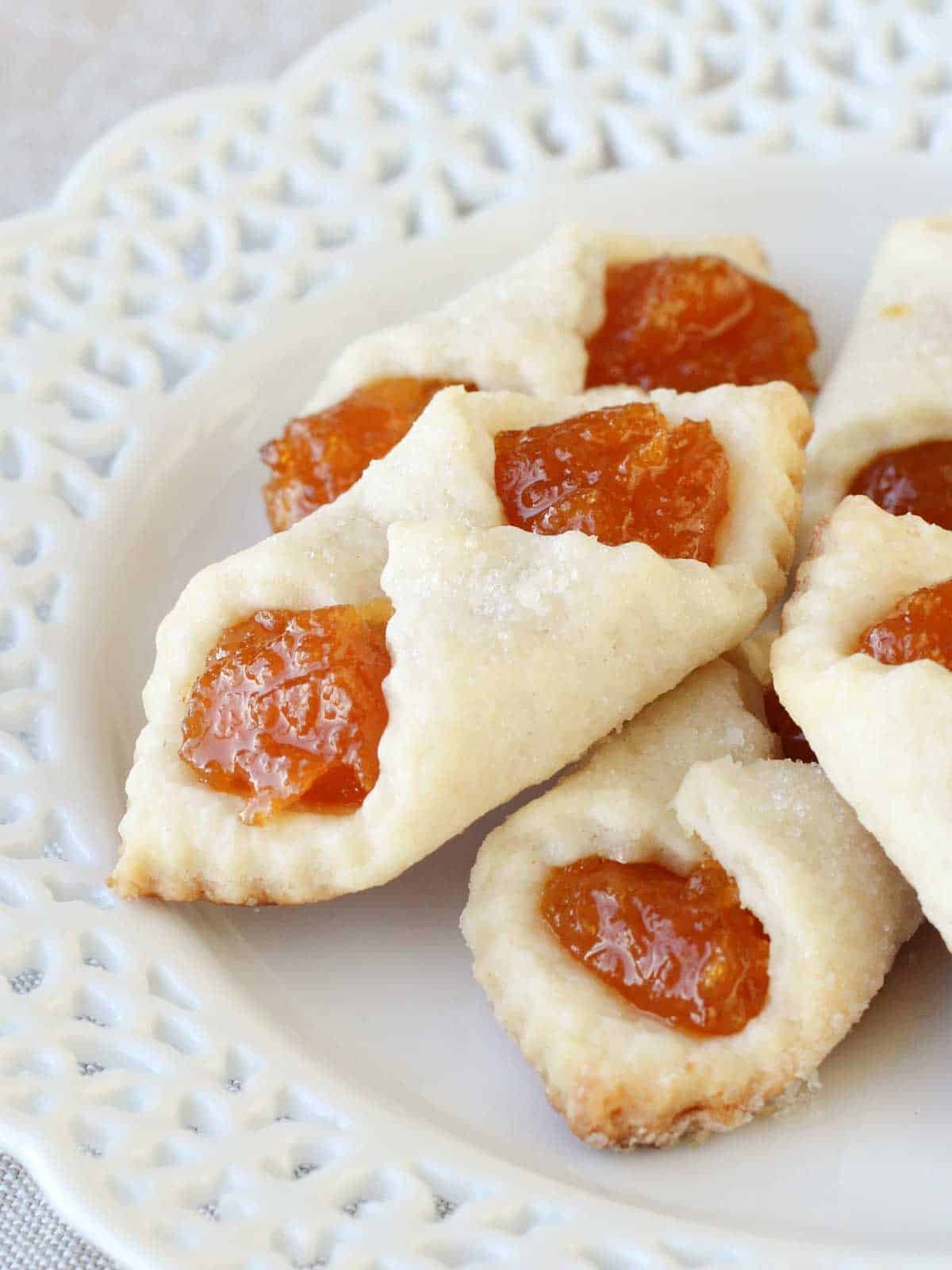
I first posted this kolacky recipe in 2013. I made and remade them until they were perfect! In this post you will find all my tips from back then and new ones I’ve learned as a professional pastry chef.
The cream cheese dough is tender, flakey and just a little bit tangy. There isn’t any sugar in the dough, so rolling it out in sugar adds a bit of sweetness and caramelizes in the oven for extra flavor! It is a technique that I also use in these nut roll cookies!
Table of Contents
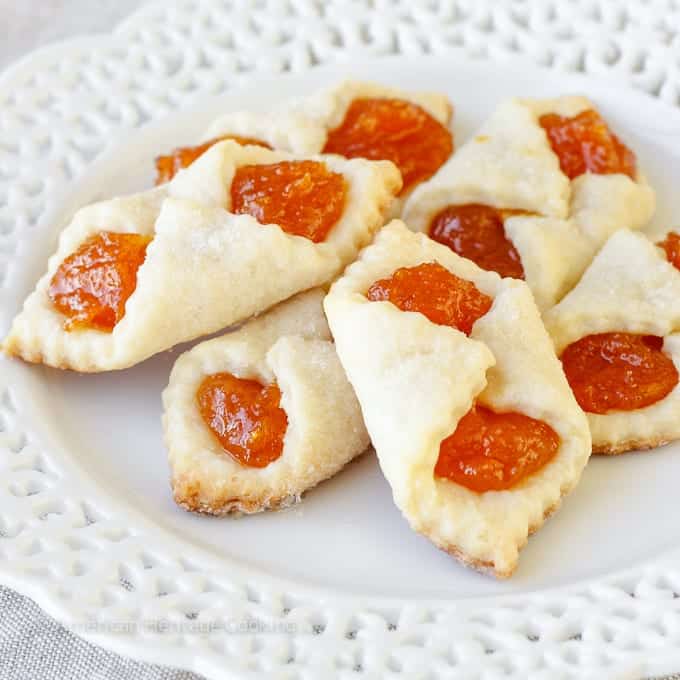

Why you will love these apricot kiffles
- They have an easy crust with cream cheese that can be made in one bowl with a hand mixer. There is no additional moisture, which makes a very rich, tender pastry.
- The homemade apricot filling recipe is made from dried apricots and can be stored in the freezer for future cookie baking! I store mine in plastic piping bags.
- The dough is rolled out in granulated sugar, which creates a caramelized crust on the bottom and a crunchy, sweet coating on top. There is no sugar in the dough, so this is a welcome addition!
What are kolacky?
Kolacky are an Hungarian Christmas cookie. They are typically made with a cream cheese or yeasted pastry dough rolled thin, filled and folded. The most popular fillings are jam, nut filling or poppyseed filling.
Ingredients
- All-purpose flour: All-purpose flour has just the right amount of gluten to make a flakey, tender apricot kolaches.
- Kosher Salt: Kosher salt is lass salty than table salt and a teaspoon weighs less than other finer ground varieties. . It heightens the flavor here and will keep your pastries for tasting dull or flat.
- Cream Cheese: I use original Philadelphia Cream Cheese for all my baked goods. Working the cream cheese into the dough adds fat and a little bit of tang. I’m no stranger to cookies with cream cheese, and I can tell you that cream cheese does not behave the same as butter when baked and will create a soft, tender cookie.
- Butter: I use unsalted butter for baking, because you want to control the amount of salt you are adding. Every brand is different and it makes adjusting the recipe a challenge.
- Granulated Sugar: Rolling out the dough in granulated sugar will add a bit of sweetness and crunch but it will also caramelize on the baking sheet for added complexity of flavor.
- Dried Apricots: I use sulphered dried apricots because they have that beautiful color. Un-sulphered will be dark brown. I use Turkish Apricots because they are plump, sweet and generally have more retained moisture than other varieties.
- Granulated Sugar: Granulated sugar sweetens and thickens the filling. You could reduce it by half and still have success with these cookies. The sweet filling balances the savory pastry for the perfect bite.
Step by step Instructions
The below instructions will give you all the tips you need to make perfect apricot kolacky cookies from the very first time! Additional instructions and measurements can be found in the recipe card below.
Make the apricot filling:
Step 1: Place dried apricots in a small saucepan and pour in just enough water to cover the apricots. Boil until the apricots are soft. Do not let all the water evaporate. Add a little bit more to keep the filling from burning.
Step 2: Add the sugar and continue to cook until thick.
Make sure your filling is thick. Thin jams or fillings will run out of the cookie and burn on the baking sheet.
Step 3: Either puree in a food processor or with an immersion blender in a bowl. If the filling is too runny, return it to the sauce pot to continue to cook.
You can make the filling ahead of time and freeze it until you are ready to use it. Just thaw at room temperature when you are ready to use.
Make the dough:
Step 4: In a large bowl or in the bowl of a stand mixer fitted with the paddle attachment, beat together the cream cheese and butter until completely incorporated and creamy (approximately 3-5 minutes).
Step 5: Reduce the mixer to low and add the salt along with small additions of flour. Adding too much at one time will overwhelm the dough and take too long to mix it. This will create gluten and tough, shrinking cookies! The dough will be soft but not sticky.
Step 6: Divide the dough into 4 equal parts and flatten each to ¾” thick. Wrap in plastic wrap and refrigerate until hard, at least 2 hours.
The dough gets all its moisture from the cream cheese and butter, but you can still overwork it. Divide the dough with a knife or bench scraper rather than tearing it, and press it flat gently. Allow the dough to rest in the refrigerator before rolling or pressing too thin.
Assemble the cookies:
Step 7: Pre-heat the oven to 375°. Move the oven rack one setting higher than the center. Line two baking sheets with parchment paper.
Step 8: Take one of the disks of dough from the refrigerator and lightly flour both sides. Spread granulated sugar on your pastry board or work surface. Place the dough on top and roll out pastry to 1/16” thick or as thin as possible. The thinner the better. If you roll them too thick, the bottom will burn before the inside has a chance to fully cook and puff up.
Step 9: With a pastry wheel or sharp knife, trim the dough into a square and then cut the square into 16 smaller squares. My dough never rolled out into a perfect circle so I would just cut as many 1 1/2 “ squares a possible, saving the scraps for later.
Step 10: Place a dollop of filling in the center of each square. I used ½ teaspoon. Gently grab two opposite corners and fold one over the other, gently pressing down to try and seal them together. Move it to a parchment covered baking sheet, placing the Rolls no closer than 1” apart. You can offset them in a diagonal pattern to get more on a tray. Repeat with all remaining squares.
You can use a little bit of beaten egg or water to seal the corners together. This can help keep them from popping open in the oven.
Step 11: Sprinkle the middles of the rolls with just a touch of granulated sugar. Bake 12-14 minutes or until the bottom edges are a golden and you can smell them. They should puff up slightly in the middle. With experience you can see when the dough is cooked. Let cool slightly on the pan before moving them gently to a wire rack to cool completely.
Chef Lindsey’s Recipe Tip
Don’t chill the assembled cookies prior to baking them. This re-solidifies the butter in the dough and will cause them to puff too much. The extra puff will open the cookies!
The traditional Hungarian apricot filling is from the Paprikas Weiss Traditional Hungarian Cookbook and the cream cheese crust recipe is from June Meyer’s Authentic Hungarian Heirloom Recipes Cookbook with my technique tips.

Substitutions
- Cream Cheese: The cream cheese is the only moisture in this dough, so if you omit it or reduce it, add water to make a cohesive dough. This will change the consistency and texture of the final cookie. Reduced fat cream cheese can be used but not whipped. Be aware that these changes will affect the final results.
- Dried Fruit: You could certainly use a different dried fruit for the filling. You might need to adjust the amount of sugar or water you add in order to get the necessary consistency.
Variations
- Pastry Cutter: Use a fluted or a straight edged cutter for a different look. A fluted cutter makes a ruffled edge that is very festive without any additional work!
- Change the Size: You could make these apricot kiffles larger without much adjustment beyond the bake time. I would not suggest making them smaller, because the smaller the kolaches, the more likely to pop open.
- Change the filling: Apricot, cherry and poppyseed are three of the most popular traditional fillings. You could also make the walnut filling recipe from my Hungarian walnut rolls as well!
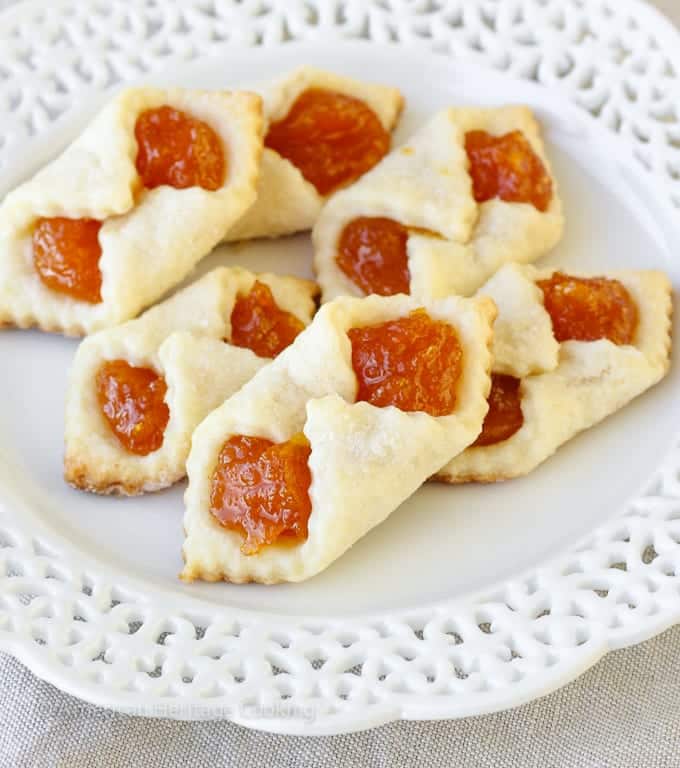
How to store kolacky?
Store baked, cooled cookies at room temperature layered between sheets of wax paper and then wrapped loosely in foil. I found that this will keep them as crisp as possible. You can also freeze them for up to three months.
The raw assembled cookies can also be frozen and then brought to room temperature prior to baking. I suggest freezing in a single layer then placing in a ziptop bag.
Freeze the dough packets and filling separately for later assembly.
Frequently Asked Questions:
Kolacky pop open in the oven when they have too much filling, the dough was chilled before baking, or they are not properly sealed. A firm press to seal should do the trick but others swear by a little bit of water or egg wash. This dough is flakey and if chilled, it will puff excessively like puff pastry in the oven. Sometimes this is desirable, but here we want those cookies to stay shut!
Apricot Kiffles and Apricot Kolaches are a cookie by many names. Multiple Eastern European cultures lay claim to these cookies and they each call them something different. In the Czech Republic and Slovakia kolaches are a type of sweet bread some of which are yeasted. Hungarian kolaches or kolachy are cookies made with a sweet pastry dough and a variety of fillings. In other parts of Eastern Europe and some parts of Hungry call these same cookies apricot kiffles. By any name they are delightful!
Yes! You can freeze fully baked apricot kolaches for up to three months. I layer mine between parchment paper or waxed paper inside a ziptop bag.
This dough is flakey and if chilled, it will puff excessively like puff pastry in the oven. Sometimes this is desirable, but here we want those cookies to stay shut! You do, however, want to chill the dough prior to rolling. This will allow the gluten to relax. It will keep the cookies from shrinking.
If you tried this recipe and loved it please leave a 🌟 star rating and let me know how it goes in the comments below. I love hearing from you; your comments make my day!

Apricot Kolacky Cookie (Kiffles)
Ingredients
For the Pastry:
- 2 ¼ cups all purpose flour
- ½ teaspoon kosher salt
- 8 oz cream cheese
- 1 cup unsalted butter softened
- ½ cup granulated sugar for rolling
For the Apricot Filling:
- 1 lb dried apricots sulfured for color
- 1 cup granulated sugar
Instructions
To make the Apricot Filling:
- Place dried apricots in a small saucepan and pour in just enough water to cover the apricots. Boil until the apricots are soft. Do not let all the water evaporate. Add a little bit more to keep the filling from burning.
- Add the sugar and continue to cook until thick.
- Either puree in a food processor or with an immersion blender in a bowl. If the filling is too runny, return it to the sauce pot to continue to cook.
- You can make the filling ahead of time and freeze it until you are ready to use it. Just thaw at room temperature when you are ready to use.
For the Pastry Dough:
- Whisk flour and salt together in a medium bowl and set aside.
- Beat the cream cheese and butter together with a stand mixer or a hand mixer until completely incorporated and creamy (3-5 minutes).
- Reduce the speed of the mixer and slowly add in the flour. I used 5 additions and completely mixed in the flour each time. The dough will be soft but not sticky.
- Divide the dough into 4 equal parts and flatten each to ¾” thick. Wrap in plastic wrap and refrigerate until hard, at least 2 hours.
Assembling the Kolaches:
- Pre-heat the oven to 375F. Move the oven rack one setting higher than the center.
- Take one of the disks of dough from the refrigerator and lightly flour both sides. Spread granulated sugar on your pastry board or work surface. Place the dough on top and roll out pastry to 1/16” to 1/8” thick. Most recipes say 1/8” but my Husband remembered them being thinner.
- With a pastry wheel or sharp knife, trim the dough into a square and then cut the square into 16 smaller squares. My dough never rolled out into a perfect circle so I would just cut as many 1 1/2 “ squares a possible, saving the scraps for later.
- Place a dollop of filling into the center of each square. I used ½ teaspoon to ¾ teaspoon for each.
- Gently grab two opposite corners and fold one over the other, gently pressing down to try and seal them together. Gently move it to a parchment covered baking sheet. Repeat with all remaining squares.
- Sprinkle the middles of the kolaches with just a touch of granulated sugar.
- Placing the kolaches no closer than 1” apart.
- Bake 12-14 minutes or until the bottom edges are a golden and you can smell them. Let cool slightly on the pan on a wire rack and then move them gently to a wire rack to cool completely.
- Repeat with all remaining dough. Refrigerate and re-roll your scraps. Amazing.
Video
Notes
Nutrition
Before you go!
Check out our other delicious, chef-developed cookie recipes!

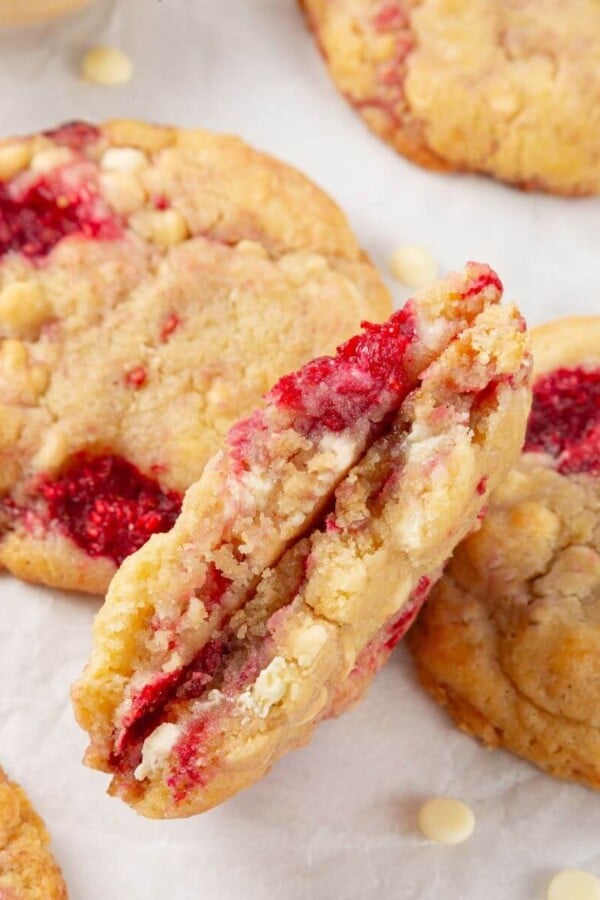
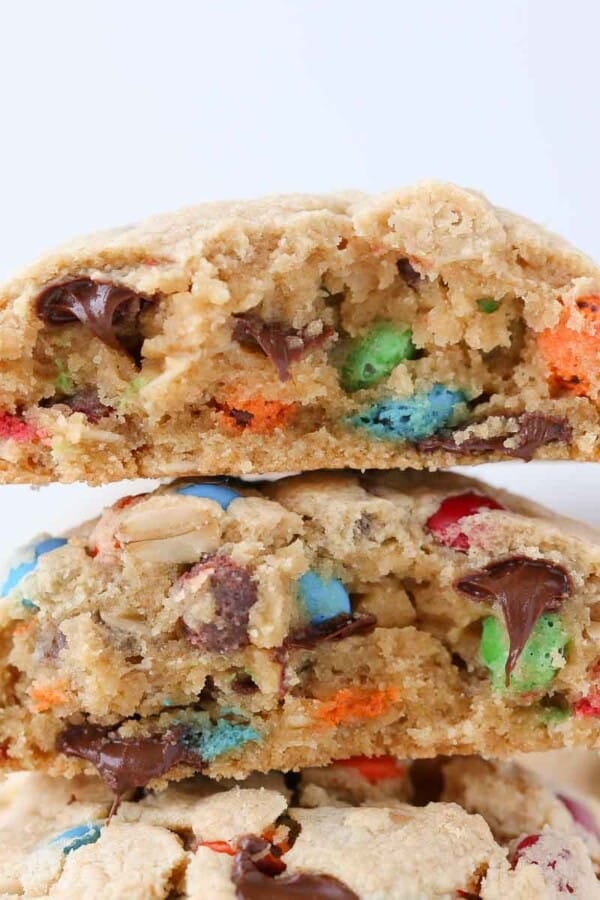











A huge thank you for your recipe, it”s really delicious !!! https://unflodebonneschoses.fr/bredele-2015-apricot-kolaches/
You’re welcome! I’ll hop over and check them out now!
Thanks for letting me include your recipe in my round-up of 60 Ultimate Cookie Exchange Recipes on Taste As You Go!
I have some peach jam that I,made this summer that is just peaches and sugar boiled down to jam. Could i reheat thsat, add a little water, and puree it to use for the filling? Although apricot does sound delish!
Hi Karen! You can absolutely do that! Peaches would be delicious with this recipe!
My mom made these while my grammy made a roll. My mom would make little balls, roll in sugar, and then roll out to fill. Both my mom and grammy would do walnut, poppyseed, and cottage cheese fillings besides the apricot.
Thank you! Made these for my churchs’ cookie party we package for the older members of the congregation that aren’t able to get about. I always bake an old fashioned cookie that would especially appeal to them, gingersnaps my go to. These are my new favs.
My first tray opened too, so followed your comment, & folded them over further and also dabbed egg wash on the opposing corners and they held perfectly. Next batch will add a prune filling and as another commenter suggested cheese, do you have a recipe for the cheese?
That’s a wonderful thing to do for the older members of your church, Shelley! I bet old-fashioned Christmas cookies light up their hearts. A bit of eggwash never hurt anyone! Good thinking! I checked my Hungarian cookbook and it does have a cheese filling recipe. I have never tried it but I trust this book. I will send you an email. Have a blessed Christmas.
I will be making these today for thanksgiving! I am hungarian/Slavic descent so these cookies are. What I grew up with in cleveland ,Ohio. I love the apricot, cherry, cheese and nut filling the best!
These would be the perfect addition to a Thanksgiving feast! My husband is Hungarian and also is from Cleveland, OH which is where his grandmother immigrated to! I’ve only tried the apricot filling in these and then a nut filling in the walnut rolls (the nut filling is to die for!). I’m going to try cherry this year. Do you have a recipe for it? I was just going to do the same thing as the apricot but substitute dried cherries?
My Slovak grandmothers both made these! So they are not just Hungarian, but are definitely from that part of Europe. And the cookie dough recipe is the same as the one that I got from a Polish baker.
That part of Europe’s history is so intertwined it doesn’t surprise me in the least that these cookies are found all over! I bet your grandmothers’ were phenomenal!
Actually, what was once the Austro-Hungarian Empire that existed for centuries covered Hungary, Slovakia, the Czech Republic, part of Poland and Austria. The Austro-Hungarian Empire was broken up at the end of WWI and the current countries/boundaries were formed then. So the foods are very similar across the entire region.
By any chance was your Husband’s Grandmother’s first name Helen? My grandmother had a sister named Helen who married a Szabo. Their maiden name was Barta
Hi Amy! No it wasn’t but Szabo certainly seems like an uncommon name. She immigrated to Cleveland, OH. Did your grandmother live there?
Wow. My Dad’s family was from Croatia and my Grandfather immigrated to Cleveland (with his Dad), too!
The kolache recipe handed down to us uses pineapple instead of apricot and also walnut mixture, as well…I don’t care for that one, but love the pineapple! I just make pineapple preserves and use that as the filling. Delicious!
Thanks and Blessings!
Hi Angie! I would love to try the pineapple filling! Another reader (from Eastern Europe) said that they made a filling with cottege cheese, pineapple preserves and an egg.
I did follow the directions exactly and my dough was very greasy. They literally melted on the cookie sheet as they baked and the filling was showing through on the bottom. Needless to say they are not tender crisp. I add LOTS of flour during rolling to try to “mop” up some of the grease as well as up the oven temp. That seemed to help some and they are edible but they turned out nothing like yours. Any idea what I did wrong?
Hi Sandra, I’m so sorry that happened to you. I’ve made these kolaches and the walnut rolls, which use the exact same dough, a half dozen times and haven’t had that problem. What temperature was your butter? Was it room temperature? That might make for greasy dough, but refrigerating the dough prior to rolling might help that. One time I didn’t properly beat together the cream cheese and butter and then I added all the flour at one time and the dough was dry and wouldn’t hold together. I also use a hand mixer to beat everything together.
You could also check your oven temperature and make sure that it actually reads 375. Mine is a very nice Kitchen Aid and it still fluctuates a lot. The only other thing I could think of is that you didn’t refrigerate it long enough. It should be firm when you take it out to roll it.
Thanks for your timely response. My butter was room temp when I mixed it with the cream cheese but the dough was refrigerated overnight before I rolled it. I added the flour in 5 increments as you suggested. The only thing I did differently perhaps is that I used a stand mixer rather than a hand mixer. I don’t know what the effect of over mixing would be, and I don’t think I did that, but maybe, as obviously I did something wrong. Maybe next time I’ll make them with my daughter and see if she can catch something I missed.
Hi Sandra! Perhaps just try to use butter that is a little less soft. Just a little cool to the touch but will still give when pressed with your finger. You could try to use the whisk attachment with your stand mixer to emulate the hand mixer’s beaters better? I hope it comes together better next time! I am so sorry they didn’t turn out 🙁
You might want to try freezing the assembled cookies for 10-15 minutes just before baking.
Following the recipe is very important especially in baking but to me it sounds like there was not enough flour and the dough must be chilled through at least three hours . I am a baker my mother was a wonderful cook and you can improvise more in cooking than baking. I can cook your basics but I am not a cook I am a baker